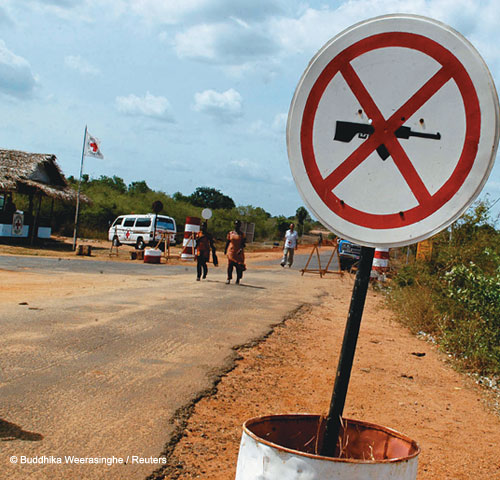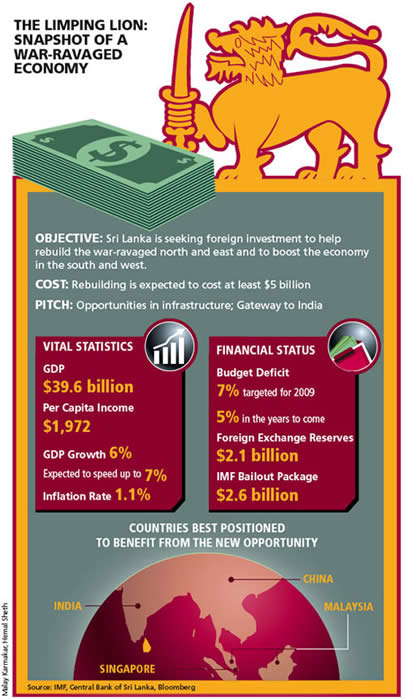Ilankai Tamil Sangam30th Year on the Web Association of Tamils of Sri Lanka in the USA |
|||
 Home Home Archives Archives |
A New Battle for Ceylonby S. Srinivasan, Forbes India, August 21, 2009
Amid the ruins of Sri Lanka's civil war lie gems of business opportunity for foreigners. But be prepared for a long, hard spell A group of 43 businessmen from Colombo, Sri Lanka's capital city, were shocked to see the devastation when they landed in Jaffna in early July. Returning after three decades, they remembered this palm-fringed peninsula surrounded by blue lagoons had once been a thriving hub for industry. As many as 750 small factories churned out everything from household articles to export items in the 1970s. Now, they were all gone. What greeted them was broken bridges, burnt homes and families torn by the 26-year-long civil war. Hardly a place to talk business. The scene elsewhere in the region is no different. The caustic soda factory in Paranthan is in ruins, the Kankesanthurai cement plant is dysfunctional and Valaichchenai paper factory has been idle for long. Even in Colombo, a city living under the constant shadow of terrorism, the mood is somber. The country came dangerously close to defaulting on its international payment obligations in March, when its foreign exchange reserves dipped to a mere $1.3 billion. President Mahinda Rajapaksa rushed to the International Monetary Fund (IMF) and got a $2.6 billion bailout that has imposed strict conditions for fiscal discipline. He will have to raise taxes and cut expenditure to rein in a whopping 7% budget deficit. Then, why does investment guru Jim Rogers now recommend Sri Lanka as the most compelling investment destination? The answer, simply, is that the civil war is over. The separatist Liberation Tigers of Tamil Eelam (LTTE) has been put down. The same ruin that kept the embers of despair aglow has now become the spark of opportunity for the shrewd businessman. "I have seen that when a long war like this ends, there rise enormous opportunities for investment," Rogers, co-founder of Quantum Fund and author of classics such as Investment Biker and Adventure Capitalist, told Forbes India. "Sri Lanka will need to be rebuilt now and there's little capital within the country." Ask Roman Scott. This Singapore based British private equity manager, with family roots in Sri Lanka, believes the island nation's time has arrived. "It is going to be one of the best investment opportunities on the planet for the next two to three years," he says. His Calamander Group has launched the world's first PE fund exclusively focussed on Sri Lanka, with a likely corpus of $50-75 million. Scott says the conflict shaved off 1.5-2.5% from the gross domestic product (GDP) and even then, Sri Lanka has been the fourth fastest growing economy in Asia in recent years. As fighting raged, most foreign investors avoided Lanka and hence there is very little competition across the business spectrum. Those quick to invest will get to choose from the business of rebuilding the nation as well as the consumer market that a healthier society will unleash. Sizing up the Pie Just how much money Sri Lanka needs to rebuild itself is still unknown. But just the initial investment needed to fix the stalled economy in the north and east is a $5 billion business, according to government estimates. Roads, bridges, schools, hospitals, power plants and even homes have to be built afresh. So, the final tally will be several times larger. But the sweet spot for the foreign investor is not the war zone. The relatively peaceful Western Province, where Colombo is located, is a ready market waiting to be tapped fully. The infrastructure and a consumer economy are already there, but the war kept away many providers of goods and services. They will come now. This province, which accounts for half of Sri Lanka's $40 billion economy, will be the first to gain from peace. Scott says Sri Lanka is today in the position that India was in 1991, minus the war, of course. Colombo has just come out of a foreign exchange crisis, needs to fix its finances and can very well use the crisis to silence protectionists and launch economic reforms. "It has all the potential of India at half the price, with no competition." In fact, Calamander is especially targetting Indians for investing in its Lanka fund. Sri Lanka has traditionally excelled in tea, tourism, garments and rubber. Business potential in these areas remains, though in niche segments within. Tea plantations, dominated by trade unions, may not be as attractive anymore but downstream segments like blending, packaging and branding will be. In the capital-intensive tourism sector, where payback can take four years or so, the risk is another terrorist attack will drive away tourists. Apparel export is crowded and dependent on single large orders. The new opportunities will not be in the sectors Sri Lanka is known for. They will be in real estate, business process outsourcing, banking, timber, pepper, fisheries, education, healthcare and of course, infrastructure. When the government and LTTE had observed a truce between 2002 and 2005, a wave of investors reached Sri Lankan shores. With a literacy rate of 97 percent, Sri Lanka attracted BPO companies,especially the ones executing accounting tasks. The country has been trying to move into a services economy too. So, there will be a huge scope for training young people in manufacturing as well as services businesses. That is why human resources firm Ma Foi Management Consultants went there in 2004. "Despite the big need for skills training, the HR scene there is not well organised," says E. Balaji, Ma Foi CEO. In fact, most students go to work rather than go to college. This has led to a shortage of graduates. Also, the official policy to promote the Sinhala language has weakened English learning in Sri Lanka over the years, Balaji says. Government Gets into the Act Rajapaksa has already taken some steps towards rebuilding Lanka. He is likely to get an assistance of $300 million from Asian Development Bank (ADB) for building projects in the war zone. ADB may also give more funds to help the export-driven economy emerge from the global recession. Rajapaksa is offering a 15-year tax holiday for investments in the north and east. He also plans to set up special economic zones to spur industrial activity. He is keen to get foreign investment and has dispatched his ministers to various countries to pitch. There are two reasons why Rajapaksa desperately needs foreign investors. Capital is expensive in Sri Lanka. Companies borrow at 17-20%. So, rebuilding cannot happen without cheaper capital from outside. Also, given that his fiscal belt is getting tighter, he has little money to spare from the coffers. The natural course for Rajapaksa would be to reform the economy, bring down interest rates and open up businesses for outsiders. But his track record is strongly socialist and the Sri Lankan polity generally favours protectionism. "There is significant pressure from his own party and other parties to reverse some of the advances they have made. I don't know to what extent IMF will really be satisfied," says Jan Zalewski, a London-based analyst with economic forecasting company IHS Global Insight. Surviving in Sri Lanka's tentative free market is not easy. A regular business decision like allowing a fuel pump can become a political row. Companies from some countries have a natural advantage either because they have the trust of the Sinhalese or understand the local nuances better. China falls into the fi rst category and India into the second. Th ese two countries are likely to play a major role in the reconstruction. "China, being a large country, is putting a lot of money here. Also, politically they are not bothered. With India, there were some political issues. But all that is getting cleaned," says Chandra Lal de Alwis, president of the National Chamber of Commerce of Sri Lanka, which sent the business delegation to Jaffna. Big Brother Is Coming India has already started pumping hundreds of millions of dollars into Sri Lanka for the rehabilitation of 280,000 internally displaced persons living in government camps. But more importantly, companies, including public sector units, (PSUs) are queuing up to invest big time. The National Thermal Power Corporation plans a 500 megawatt, $500 million power plant in a joint venture with Ceylon Electricity Board. This will be one-fifth of the country's total capacity currently. Another Indian PSU, Power GridCorporation, wants to set up an undersea transmission link between the two countries. Construction and engineering giant Larsen & Toubro (L&T) will surely play a big role in the post-conflict construction. A most symbolic venture is Sri Lanka's tallest building (59 storeys) being built in Colombo by an L&T joint venture. India's largest enterprise, Indian Oil Corporation (IOC), runs about 150 fuel stations in Sri Lanka, the country's largest storage facility, an oil terminal and a lubricant blending plant. It is eyeing network expansion and new business segments. Ashok Leyland trucks and Hero Honda vehicles are already popular and they have plans to further penetrate the market. Asian Paints, which runs a 5,500 kilolitre facility, sees the tiny market for its products booming in the coming years and is expanding accordingly. Bharti Airtel, which entered the island with its mobile phone services last year, has already invested $250 million and a like sum is on its way. The list of Indian companies lining up investments in Sri Lanka is long and impressive. But not everyone is happy. The inwardlooking economic stance of politicians has often come in the way of business decisions. For instance, Lanka IOC has not been given the freedom to expand its fuelpump network or get into new segments like selling aviation fuel. The company was locked in a dispute over subsidy payment it was owed. "We need to be given more opportunities," says K.R. Suresh Kumar, managing director of Lanka IOC. "There is a clarity required in terms of economic policy. There is some sense of reforms. But they seem to go back in time. Th e fear of losing control of state-run companies should go away," he says. The agreement for NTPC's power project has also been delayed over questions on payment security. Weighing the Risks What can go wrong for foreign investors in Sri Lanka? A return of violence or restrictive policies. Analyst Zalewski says the risk of violence will not go away unless Rajapaksa solves the underlying problem of Tamils and gives them equal rights. But Calamander's Scott thinks the government has effectively contained the Tigers and the risk of violence is very low. Even the suppression of free expression by Rajapaksa's government, while condemnable, will not affect business, he says. "Sadly, economics and democratic principles are not really that strongly related." All said, Sri Lanka has two choices today. It can shrink back into a protectionist regime and miss this historic opportunity to become an economic power. Or, it can take foreign capital and expertise to rebuild itself, solve the ethnic problem, add the Tamil population to the work force and forget violence forever. |
||
|
|||


